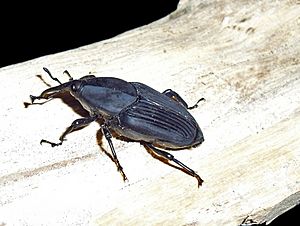Rhynchophorus palmarum facts for kids
Quick facts for kids Rhynchophorus palmarum |
|
|---|---|
 |
|
| Scientific classification | |
| Synonyms | |
|
The South American palm weevil, also known as Rhynchophorus palmarum, is a type of snout beetle. These beetles are quite large. Adult weevils are black and about one and a half inches long. Their larvae, which are the young stage, can grow up to two inches long.
Contents
What is the South American Palm Weevil?
These insects are drawn to palm trees that are hurt. Injured palms release special smells that attract the weevils. The weevil larvae dig into the center of palm trees. When they feed, they can seriously damage or even kill the palm. Their feeding also creates openings for other plant diseases.
Why are these Weevils a Problem?
The South American palm weevil is a major pest. It harms important farm crops like coconut, date, and oil palms. This weevil attacks many different types of plants. It has been found on thirty-five different plant species. Sometimes, it also causes problems for sugar cane.
This weevil can also spread a serious disease. It carries a tiny worm called a nematode. This nematode causes a disease called Red Ring Nematode. This disease affects coconut, oil palm, and date trees. The weevil acts like a "vector," meaning it carries the disease from one tree to another.
The weevil carries the nematode in a special survival form. By the time you see signs of the disease, the palm tree is often already dead. Adult or young weevils can get infected with the nematode. However, only female weevils carry many nematodes inside them. They can spread the disease when they lay their eggs.
Life Cycle and Reproduction
Female weevils can lay many eggs, sometimes up to 693! These eggs hatch in about three to five days. The young weevils, called larvae, spend seven to eight weeks growing. During this time, they feed on the soft center of the palm tree.
After feeding, the larvae leave the palm's center. They then build a cocoon from palm fibers. They might build this cocoon in the base of palm leaves. They can also build it in leaf debris at the bottom of the tree. The pupa stage, when they change into adults, lasts one to three weeks. Adult weevils then live for about five to eight weeks.
What Plants Do They Eat?
The South American palm weevil mainly feeds on several types of palms:
- Cocos nucifera (coconut)
- Phoenix dactylifera (Date Palm)
- Elaeis guineensis (African Oil Palm)
- Euterpe edulis (Assai palm)
- Metroxylon sagu (Sago palm)
- Phoenix canariensis (Canary Island date palm)
They also sometimes feed on other plants, which are called secondary hosts:
- Sugarcane
- Banana
- Cacao
- Custard apple
- Breadfruit
- Papaya
- Citrus
- Mango
- Avocado
- Guava
Where Do South American Palm Weevils Live?
These weevils are originally from South America. They live from Argentina north through Central America to central Mexico. They are also found in the Caribbean islands. This includes places like Barbados, Dominica, and Trinidad and Tobago.
Recently, these weevils have been found in new areas. They were seen in Arizona and Texas in the United States. However, these populations do not seem to be permanent. More established groups were found in 2010. These are in Tijuana, Mexico, and San Diego County, California. These weevils are causing serious damage in these new areas.
Weevils as Food
For hundreds of years, people in South America have eaten the larvae of these weevils. They are a good source of protein, minerals, and vitamins like Vitamin A and Vitamin E. These beetles and their larvae have many different names in South America. Some common names include cucarrón, suri (in Peru), and chontacuro (in Ecuador).
See also
 In Spanish: Gorgojo negro del cocotero para niños
In Spanish: Gorgojo negro del cocotero para niños


